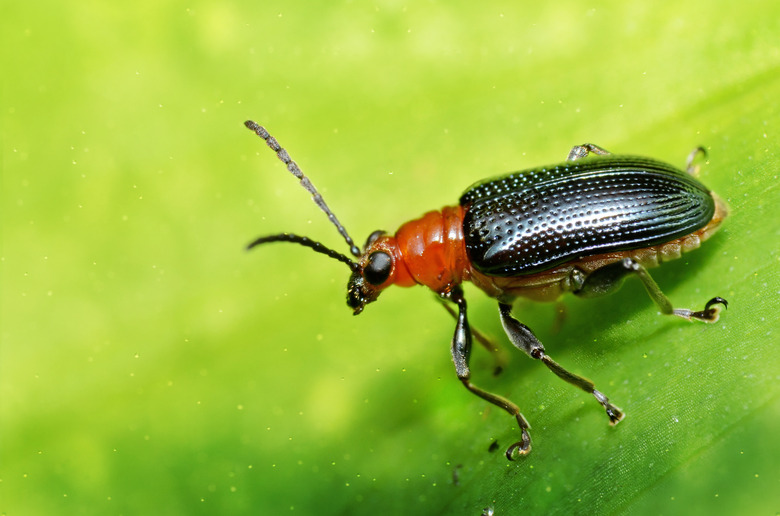How To Identify Beetles In Ontario, Canada
There are many different species of known beetles in Ontario. They often live on plants, but many burrow in the ground and some even swim. Most species of beetles have a life cycle of one year, and go through four different stages. The eggs, laid by the adult female, hatch into larva, which feed and grow. The larva turns into pupa which does not feed and eventually turns into the adult. Beetles adapt to their environment and time the laying of their eggs to reach adulthood when food is most plentiful. Ontario has long harsh winters with little vegetation and beetles will be identified in spring or summer when plants and ponds are alive with food.
Identifying a Beetle
Step 1
Look at the body of the insect. The order Coleoptera, commonly known as beetles are found throughout Ontario. Easy to identify with their armoured bodies, beetles have two pairs of wings. The top hard pair, covers over the delicate inner wings to protect them. Different from other insects, their wings meet in a straight line down the middle of the back. In flight, the top wings spread apart and the flight wings, underneath, unfold and extend. Most beetles are brown or black, but their wings are sometimes striped, spotted or colorful. Beetles have a long antennae, protruding from the head.
Step 2
Check in open forests and on woodland walks in early spring for Ontario's Cicindela sexguttata, known as the Six-spotted Tiger Beetle. The common beetle is a metallic green and despite it's name it does not always have spots and may only have two or five spots. Look in sandy and gravel areas for most of the tiger beetles in Ontario. The most abundant in Southern Ontario is the Cicindela scutellaris, found in sandy roads and inland dunes. The colors vary from purple to green and can be identified by the white marking at the edge of the wing covers.
Step 3
Look no further than your garden for a variety of beetles. Sap Beetles, known as beer bugs, will dive into your beer and wine as you try to enjoy these beverages outside in Ontario. The tiny beetles are dark with yellow marks on each wing. Check on rose foliage and stems for the slow moving Rose Chafer. These beetles are fawn colored, covered in yellow hairs and have long legs. Japanese Beetles can be found on flower blooms after they open and other foliage. Check for a metallic green color with a coppery brown wing cover, and white hair around the abdomen.
Step 4
Look in ponds and streams to identify water beetles that may be found in Ontario. The large Predaceous Diving Beetle is oval shaped and hard. The common beetle is usually black or brown, but may have green, bronze or brown spots or stripes. The hind legs are fringed for swimming. Whirligig beetles are often spotted in groups, spinning on the surface of ponds. The shiny black beetle has divided eyes of equal parts, one sees above the water surface and the other sees underneath.
Things Needed
- Net for catching beetle
- Glass jar or observation container for viewing beetle
Warning
Some insects bite or sting and it is safer to use a net or container if catching them for identification.
Cite This Article
MLA
Frances, Jean. "How To Identify Beetles In Ontario, Canada" sciencing.com, https://www.sciencing.com/identify-beetles-ontario-canada-8277822/. 22 November 2019.
APA
Frances, Jean. (2019, November 22). How To Identify Beetles In Ontario, Canada. sciencing.com. Retrieved from https://www.sciencing.com/identify-beetles-ontario-canada-8277822/
Chicago
Frances, Jean. How To Identify Beetles In Ontario, Canada last modified March 24, 2022. https://www.sciencing.com/identify-beetles-ontario-canada-8277822/
